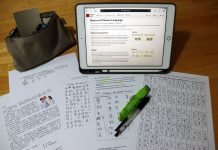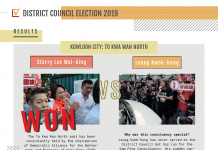Dozens of elderly patients sit silently on benches in the lobby of Kwong Wah Hospital. The only sounds to be heard are the announcements calling for patients. Ms Lee, in her 70s, keeps an eye on the numbers flashing up on the screen and carefully checks them against the number on her chit. She knows she faces another hour of waiting.

Despite the frequent long waiting times in Hong Kong’s public hospitals, many elderly accept they have to wait since they are enjoying either free medical care or paying far lower fees than they would pay at private hospitals or clinics.
This is particularly true for those with chronic diseases like Lee. She has to go to the hospital for regular kidney check-ups every month and kidney dialysis costs her more than $10,000 every month.
Lee relies on a government subsidy of a few thousand dollars a month to pay for her medical expenses. Her son and daughter, who each have their own families to support, foot the rest of the bill.
Lee lives in a private elderly home which adds to their financial burden. She is waiting for a place in a government-subsidised elderly home that would cost $2,000 to $3,000 a month, a tenth of the cost of private elderly homes.
Like Lee, most of Hong Kong’s elderly population depend on government medical services. As highlighted in the latest Policy Address, Hong Kong’s aging population presents a huge challenge for its public health system. The number of people aged 65 or above is expected to rise from the current 0.9 million to 2.1 million in 2013, which represents a quarter of the total population.
The recurrent government expenditure on medical and health services in 2012 will be $45 billion, an increase of 8 per cent on the previous year and 17 per cent of total government expenditure.
In an attempt to relieve the increasing pressure on public medical services, the government introduced the Health Care Pilot Scheme in 2009 to encourage the elderly to use private health care services. Under the scheme, non-means tested medical vouchers were issued to people aged 70 or above. Each person was given five $50 vouchers, that is, a total of $250 to spend on private primary health care services.
Two years after it was launched, the Hospital Authority reviewed the scheme last year. Of just over 1,000 elderly people who were interviewed, only around a third said they used private primary care services more than they had before. The others did not change their behaviour and 26 per cent of these respondents said the reason was because they were used to seeing public doctors; a similar percentage said the subsidy amount was too small.
Although the total value of medical vouchers was increased from $250 to $500 following the review, many believe it is still far from satisfactory.
Tang Kam-ying, 79, visits clinics several times a month. He had already used three of his 10 vouchers for the year by February and thinks that even after the increase, the vouchers cannot meet the needs of the elderly.
Each time Tang visits a private clinic, it costs him two vouchers. So, when he chooses to see private doctors, he opts for those that charge the lowest fees.

Cheung Kwok-che, a legislator from the social welfare sector, uses a Chinese idiom to describe the health care vouchers as “chicken ribs”, something that is tasteless but a waste to throw away. “It cannot solve the problems we want to solve,” explains Cheung. “But it is a waste if you abandon it, that’s $250.”
According to Cheung, the lowest price of a consultation at a private clinic is $180 in public housing estates. In some districts the fee may reach $250 or higher. Some specialist clinics charge triple that.
However, Cheung says the idea of the scheme is a good one. “Medical vouchers provide the elderly with an extra option,” Cheung says.
Apart from the low value of the vouchers, another problem faced by the elderly is the limited number of enrolled health care service providers who will accept them.
There are more than 6,000 doctors in private medical practice in Hong Kong, but at the end of 2010, there were fewer than 2,800 medical service providers who accepted vouchers. Of these just over half were doctors of western medicine.
Dr Wong Wai-hong, a specialist in geriatrics who owns a clinic in Tsuen Wan, joined the scheme because he thinks it is especially helpful for the elderly on low incomes.
However, he says some health care providers might not adopt the scheme because it is not particularly profitable and they do not regard the elderly as a big source of their income.
What is more, Dr Wong says the administration process is complicated and time-consuming. The elderly are not given physical vouchers and the whole process is carried out online. It takes Wong two to three minutes to complete the process.
He says that for some doctors who are not comfortable with using computers, the phone system would be even more complicated. Many of them would give up being part of the scheme.
Another consequence of not having physical vouchers is that providers have to confirm the number of vouchers to be used every time and the patient has to sign a consent form. Dr Wong finds it difficult to explain the process to his elderly patients.

He says some of them have poor memories and would forget the number of vouchers they had already used. When he checks their records for them, they sometimes suspect him of lying. It takes a lot of time to convince them.
Other times, arguments can ensue over payments. When Dr Wong charges $190 for the medical fee, he tells the patients they can use three $50 dollar vouchers and pay the remaining $40 in cash. He says some of his elderly patients cannot understand why they are being asked to make up the difference and he has to explain to them.
Another problem is that it is hard for the elderly to identify voucher service providers in the first place. Providers display a green label in an easily-visible place and there is also a list of the providers on the government Health Care Voucher webpage. But it is still hard for many elderly to identify the clinics, let alone check for them online.
Lung Pui-si, 73, once walked around looking for a dentist who accepted the vouchers. She visited six or seven dental clinics without finding one who would accept them.
While some elderly may prefer to use vouchers in private clinics for minor health problems, the limited number of providers has put them off using them.
The shortcomings of the system means vouchers have not achieved the desired aim of shifting elderly patients from public services to private services. In the meantime, the elderly also face difficulties when they use the public system.
The shortage of funds and doctors leaves public hospitals with no choice but to prioritise cases. Those who have non-urgent conditions will usually have to queue up for years for operations, or even just check-ups.
Lau Suk-ying, who is 84 and had cataracts, waited for three years for an operation. Her vision deteriorated and she could hardly see the moving cars on the roads. “When I went to the check-ups, the doctors always said my eyes were not ready and they could not perform the surgery,” Lau says.
Due to insufficient resources, doctors in public hospitals prefer not to operate immediately on cataract cases until they develop into the final stage. Lau eventually went to the private Precious Blood Hospital, where she only had to wait three days for an operation. She received a $5,000 subsidy from the government and had to find another $8,000 from her family and savings to pay the bill.
Apart from waiting times and fees, the distribution of hospitals and clinics are another concern when it comes to health care for the elderly. Wong Kam-choi, the chairman of the board of directors of Sik Sik Yuen, a charity that offers different medical services, is worried about reclusive elderly people who are reluctant to leave their homes.
Some elderly people have suffered strokes but do not seek therapy because they think that queuing up for half a day for a 10-minute therapy session is a waste of time and the cost of transportation.
Wong says the elderly often have to travel to different clinics for different ailments. He believes integrated clinics would spare them time and trouble.
Yet, despite all the problems with health services for the elderly, some are grateful for the support and subsidies they get from the government. For those who do not have family support or savings, especially those who receive Comprehensive Social Security Assistance (CSSA), public hospitals meet basic medical needs. Elderly recipients of CSSA are exempted from consultation fees and most prescription charges. They are also charged a lower dialysis fee and may even receive free dialysis.
As the territory ponders how it will provide quality health care for its growing population of senior citizens, Legislator Cheung Kwok-che says the crucial point is how the government views future elderly services. He says the elderly should not be viewed as a burden once they are no longer in the workforce. “How can society make use of their golden old years and knowledge to contribute is the question,” says Cheung. “That’s why basic medical protection is important.”










































